Bayern’s problems with positional play
Beforehand: To only look at Niko Kovas as the single source of guilt for the current misery would be a mistake. The squad planning must also be criticized. In addition, the players are of course also under obligation. Many leaders like Mats Hummels, Thomas Müller or Arjen Robben are currently completely out of form.
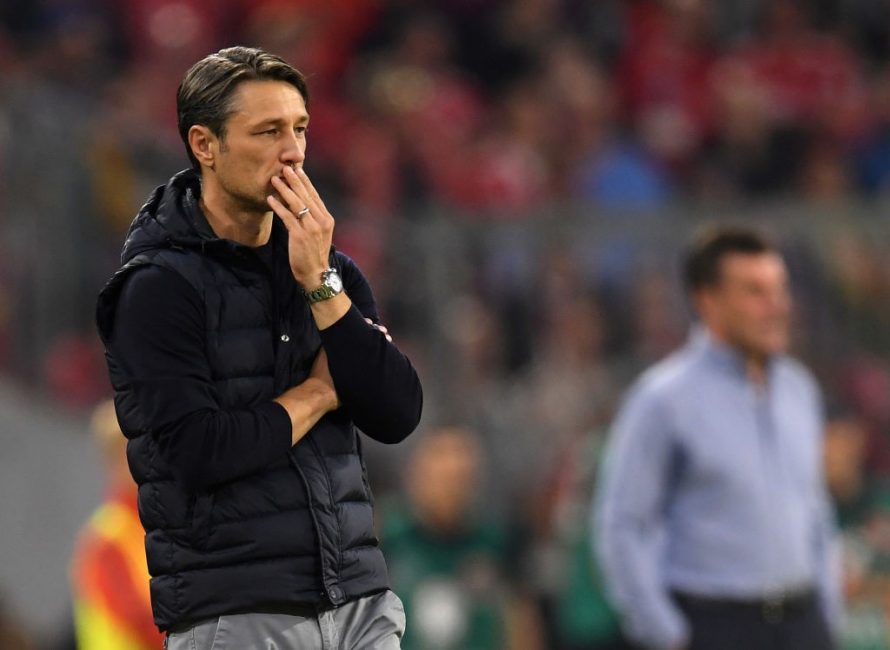
(Photo: Matthias Hangst/Bongarts/Getty Images)
But an analysis of these problems has to be done internally, from the outside it makes more sense to take a look at what is happening on the pitch. Especially the harmlessness of the Bayern offence as well as the weak counter-pressing surprised and astonished many fans. Because at the beginning of the season many things looked different. The players performed and Kovac’s plan worked. However, there were already first signs of the problems that emerged now.
The positional play, that is no positional play at all
Before we go into detail, we should briefly look at Niko Kovac’s basic approach. In the media and social networks there is always wild discussion about the positional play of Bayern. Louis van Gaal already coined the term positional play. Pep Guardiola is also known to be a great advocate of positional play. However, it should be differentiated here.
In Germany, the term positional play often refers to the occupation of the positions of the players on the field or how they move as a team. The positional play of Pep Guardiola, in the Spanish Juego de Posición (short: JdP), does not only refer to the positioning of the players, but stands for an organized form of the game with the ball. The Juego de Posición comprises various principles that a team in possession of the ball tries to implement. For example, there should never be more than two players on the same vertical line and never more than three players on a horizontal line.
To differentiate: Niko Kovac also attaches importance to the appropriate positioning in possession of the ball, but leaves the players much more room for manoeuvre. Because Kovac does not use the JdP, accordingly the players in possession of the ball have fewer reference points to position themselves and the attacks seem less planned.
The basic idea of Niko Kovac
The fact that Niko Kovac does not use the principles of JdP or only uses very few of them is not bad. Because even without these principles you are able to perform a good game with the ball. Niko Kovac’s focus so far has clearly been on wing play. At the beginning of his tenure he implemented movements, combinations and moves on the wings in order to break through into the danger zones in and around the penalty area.
For this, a triangle consisting of the eight in the half space and the wing player as well as the full-back is usually used. A frequently occurring sequence is a pass on the wide standing wing player, while the eight is in the half space. On the right side, Joshua Kimmich often starts into the depth between Müller and Robben. This poses problems for the defence and gives the Bayern various options to continue the attack. Either Kimmich is sent into the depth, the eight gets the ball diagonally or the wing player can use the resulting space to dribble.
A second striking trait in the Bayern game is the positioning of the eights in the build-up play. If the central defenders or Thiago have the ball, then the eights usually push very far forward. It is not uncommon to observe that they are on the same line as Lewandowski. The pole then drops from time to time to get the ball. The basic plan behind this is to overload the opponent’s last line and thus create space in front of the opponent’s defence.
The problems in the build-up game
Already in the build-up game small details can be recognized, which make life difficult for Bayern. Basically these are not dramatic and a well-structured game in possession of the ball is still possible. Surprisingly, the central defenders still have few tasks in the build-up of the game. Most of the passes from Hummels, Süle and Boateng go to the full-backs or Thiago. Rarely do you see that one of the central defenders is running with the ball at his foot towards the opposing defensive block.
Furthermore, the central defenders tend not to be as wide-spread as in the past. This sometimes results in difficult passing angles. Especially if you want to try to play the ball into the center. As a result of these small details, Bayern’s game is already focused on the wings very early on.
In addition to the position of the central defenders, the positioning of the full-backs also leads to occasional problems. Because Alaba and Kimmich push forward relatively late. Most of the runs they start from deep.
In the build-up game the full-backs are still relatively deep. This can have fundamental advantages, if it is used correctly, which Bayern however does not do. The low position of the full-backs leads to the fact that a pass to the outside does not mean any gain of space for Bayern. In addition, the opponent can concentrate on closing the center and still has enough time to press the full-backs when they receive the ball.
Kimmich and Alaba don’t get a good passing angle when they receive the ball. The opponent can not only easily press, but also block all the passing lanes into the centre. In the end, the only options are a back pass, which sometimes even leads to a loss of space, or a pass to the wingers. But then you are already trapped on the wing.
There is a hole in the middle
If Thiago continues to pick up the ball in addition to the deep defenders, the result will be a very large hole in Bayern’s midfield. Currently, the unoccupied space regularly leads to problems in the build-up game of Bayern and prevents a versatile offensive game.
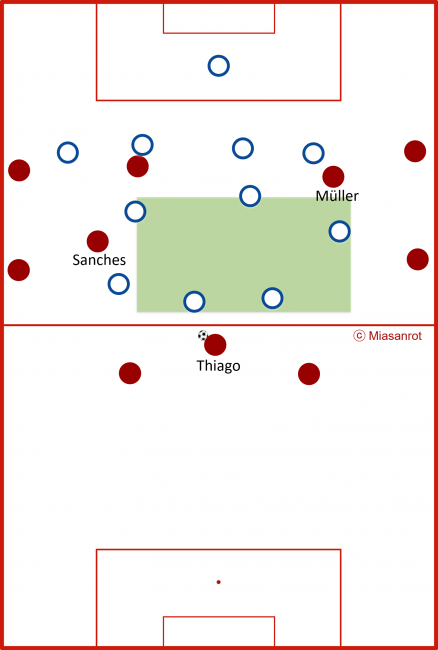
Against Hertha and even worse against Ajax Amsterdam, you could observe this hole. The opponent can secure the spaces quite easily and switch to high pressing. Because the missing occupation of the spaces between the lines leads to the fact that the opponent can press very easily Bayern’s build-up play without having to pay attention whether in the back a Bayern player stands free.
The high eights and the missing occupation of the center
This article is a bit like a Bayern attack. After the problematic build-up of the game it usually goes quickly to the outside. Why? Among other things because of the position of the eights.
In the last games the high eights have become more and more a problem. The individual positions do not always fit. Too often one can observe how both eights stand very high. Accordingly, a large hole gapes in the half space. In addition, the eights under Kovac push quite far outwards to support the wing play. But accordingly nobody occupies the space between the lines anymore. The mentioned hole in the center is the result.
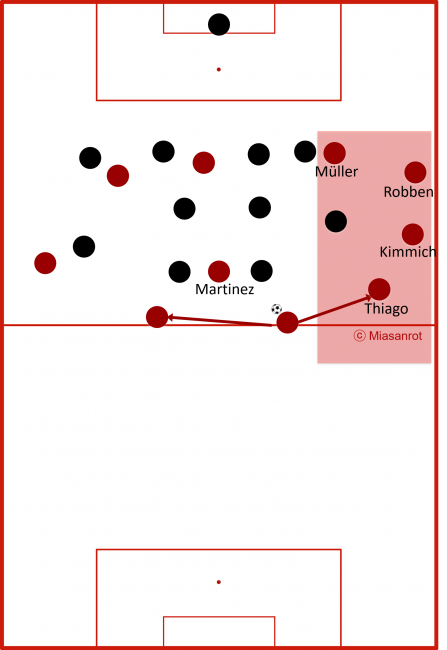
Furthermore, the sometimes very high positions of the eights mean that nobody occupies the space between midfield and the opponent’s defence. Bayern then has four or five players in the last line, but there are hardly any connection options if a pass reaches the eight. The counter-pressing is also affected. In principle the team is divided into two parts, which are connected only by the double wing occupation. Switches of play are no longer possible in this way.
If the eights do get free between the lines, Bayern are immediately dangerous. Leon Goretzka in particular shows a good feeling for the open space and is a danger due to his routes.
At the beginning of the season one of the eights often dropped deep to support. Together with Thiago, he then occupied the space between midfield and the opponent’s attack. When Bayern attacked on the side, they had better protection on the one hand, and on the other hand a starting point for a switch of play.
In the current phase the eights move mostly immediately very high, after they supported on the wing. Bayern’s structure then doesn’t allow for any more switches. Consequently, against Ajax one could observe more and more crosses, which were badly secured.
Missing follow-up options
As already mentioned, FC Bayern currently lacks the follow-up options after a successful offensive action. For example, if they could bypass the opponent’s lines, or if they successfully changed sides. Consequently, it is quite difficult for Bayern to display a goalscoring threat after they have overplayed an opponent’s line.
On the wing the follow-up actions are not so bad. There are quick overlapping runs or Lewandowski supports close to the ball. There is always a support at the wing and through the existing movements Bayern actually get into good positions for crosses. However, the isolated wing attacks are the easiest to defend for the opponent, especially as there is not always the possibility to move quickly due to the insufficient occupation of the center.
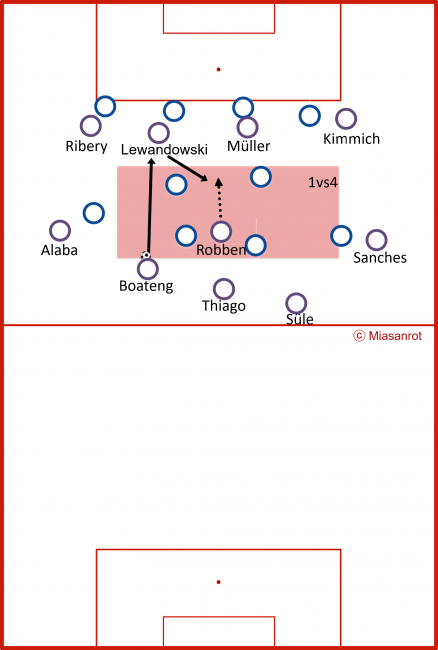
In the centre the situation is usually different. As mentioned, there are sometimes too many players on the same line. The game over the third can hardly be used and ball losses are the result. Since the center is mostly hardly occupied, those ball losses have severe consequences. Niko Kovac’s team is open, but can’t go into counter-pressing because too many players are positioned too far away from the ball. The result: counters.
The bad positioning
As already mentioned Niko Kovac probably doesn’t use any elements of the positional play, at least there are few elements to be seen in the Bayern game. Especially the positions on the field often seem improvised, because either two players take the same position or nobody occupies this position. In addition, Bayern seldom lure the opponent with short, fast passes in order to use the resulting spaces by moving the defensive with the help of a switches of play.

(Photo: Matthias Hangst/Bongarts/Getty Images)
Also, the movements of the players without the ball do not always fit together. For example, Müller and Kimmich had already sprinted into the same space after a pass by Robben. Usually an indication of a lack of coordination. However, this cannot be said with certainty. The inappropriate movements of the players are only visible very often. If you want to know more about it, you should take a closer look at James’ freewheeling behaviour against Gladbach.
Conclusion
It’s definitely not all bad at FC Bayern. As already mentioned in the beginning, it’s about the details. Niko Kovac has to turn a few screws in order to structure the game of Bayern in possession of the ball better again. The occupation of the middle and in between the lines is essential. The quickest way to solve the problems is to adjust the position of the eights a bit. If one of the eighths would support Thiago in the centre more often, Bayern would have far fewer problems. But maybe we’ll see something more unusual again. Moving Joshua Kimmich inside could also solve many of the problems of Bayern in possession of the ball.



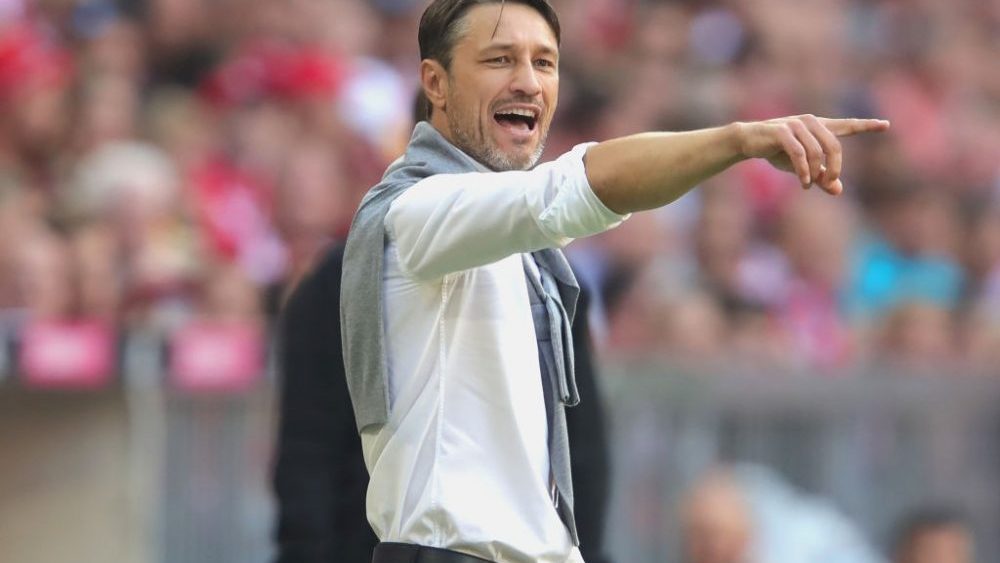








“The inappropriate movements of the players are only visible very often. If you want to know more about it, you should take a closer look at James’ freewheeling behaviour against Gladbach.”
Not sure what this means. Can you explain in greater detail? Ideally, what should be corrected in how the team played against Gladbach?
James moved a lot without the ball and dropped deeper to receive the ball from the centre-backs. However, he blocked a lot of passing lanes with his positioning. Furthermore, he was positioned in front of the first defensive line of the opponent so he didn´t help to break the lines. It was just an indicator for me, that the players can move extremely freely and don´t have to occupy certain spaces. Those movements just do not fit together and that´s why Bayern could be better in position with more guidelines on positioning
Thanks. I didn’t play as close attention to this but noticed that James started out in the right wing, and later when Gnabry and Sanches were substituted he had to drop deeper. So not sure whether he did this the whole game or during a particular half. But I do agree that the midfield is often haphazard in terms of positioning and I’m not sure if the coach and team can see it happening and are unable to convey instructions properly because of language issues or whatever.